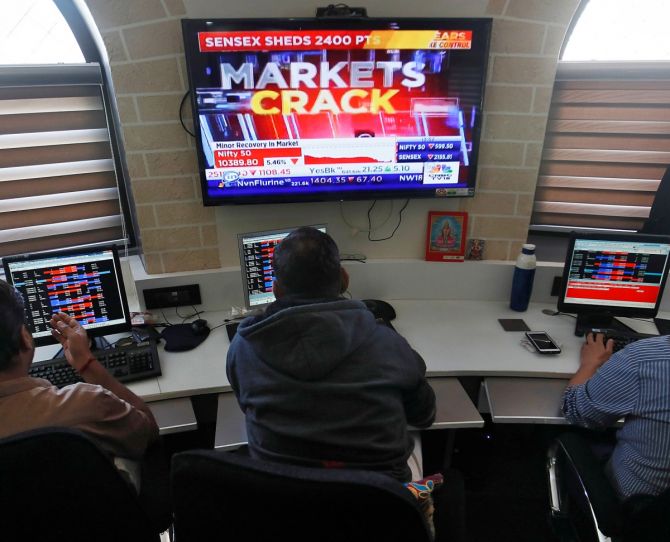'Slower-than-anticipated recovery can be a bigger risk this time than a liquidity-driven event -- at least for India.'

It will be unfair to give credit for India's recent outperformance only to structural issues in other countries, says Ashutosh Tikekar, head of global markets, India at BNP Paribas.
In an interview with Samie Modak/Business Standard, Tikekar says the two bigger risks for the market is recovery stalling and the cost of funds rising.
What explains India's sharp outperformance seen in 2021, especially since August?
We think that improving on-the-ground data points, supportive government policies, a proactive central bank, higher vaccination rates, and structural issues in other emerging countries are behind the outperformance of the Indian markets.
India has seen a steady upgrade in consensus earnings, several supply-side policy changes, and has enjoyed liquidity support from the Reserve Bank of India.
Various high-frequency indicators, we track, point to a sustained recovery through FY22 and FY23.
For example, the pick-up in property sector volumes can have a multiplier effect on the economy by way of higher demand for steel, cement, paints, tiles, and other construction materials.
Furthermore, we see a change in on-the-ground sentiment that suggests a revival in the corporate capex plans.
Most promoters can meet their debt obligation requirements despite a severe second Covid wave in Q1FY22.
This should also bode well for the banking system.
Lastly, we also think the Indian market has benefited because investors have looked to minimise the regulatory risk and the challenges in the property market in China.
We continue to remain positive on India from a long-term perspective, though there could be some blips along the way.
How will the negative investor sentiment towards the Chinese markets play out for other markets, particularly India?
Negative sentiment about other markets at best helps at the margin.
The company's structural drivers need to be in place for investor sentiment to stay bullish.
Investors always have an option to stay in debt or relatively safer asset classes if the bottom-up story of a particular country is not strong.
It will be unfair to give credit for the recent outperformance of India to structural issues in other countries.
Investor sentiment is positive in India due to earnings upgrades and supportive valuations.
Sectors, such as financials, which are more than 40 per cent of the benchmark, are still trading at mean valuations, implying the potential for further re-rating.
What are the key risks over the next 6-12 months?
The two bigger risks are recovery stalling or slowing down and the cost of funds rising, led by central banks' action to counter inflation.
Risky assets tend to love liquidity and any significant change on that front can be a risk.
This is further substantiated when you look at history.
The start of any correction is usually a liquidity event, which in a few months leads to a systemic risk due to some major player defaulting.
In the context of India, IL&FS was the last such event wherein NBFCs/HFCs posed a significant systemic risk.
This time, most large corporations are better prepared with lower debt to equity or higher capital adequacy in case of large financial lenders.
I believe, slower-than-anticipated recovery can be a bigger risk this time than a liquidity-driven event -- at least for India.
What is your reading about the US Fed's recent meeting?
We think that the Fed leaned more decisively towards a November taper at its meeting this week.
The Federal Open Market Committee saw softening in activity and employment from new COVID-19 cases as transitory, raised its inflation projections, and also saw a steeper path for policy rates than previously expected.
Therefore, a tapering of asset purchases of $15 billion per month starting this November -- assuming the September payroll print at or above 400,000 -- is now our central case. We expect the first rate hike in Q4 2022.
How will policy normalisation impact stocks, bonds, and currencies?
We believe most investors have already started factoring in policy normalisation.
Most macro indicators are back to pre-Covid levels.
Therefore, it is only logical that central bank policies will gradually normalise.
In an event where central banks see growth faltering, there is a possibility of them halting their tightening plans or even loosening again.
Opening up of the economy is positive for equities, while bonds and currencies to remain stable in the near-term given the Fed tapering announcement is well-telegraphed.
Will India's valuation premium over other EMs prompt FIIs to look elsewhere?
On an absolute basis, valuations are expensive relative to history.
But relative to prevailing bond yields, equity valuations look fair.
Corporate earnings, high-frequency indicators, and tax collections have improved over the past few months.
That said, higher yields would be a risk to the markets.
In such a scenario, capital tends to gravitate back to traditional safe havens in developed markets, rather than move to other EMs. That is what the theory says.
However, in the case of India, given the strong top-down structural growth story for at least the next 10 years, supportive government/central bank, good quality management teams', and improving on the ground situation, we expect premium valuations to sustain.
What is the outlook for the rupee?
We have seen close to $3 billion of FPI inflows in both debt and equity segments in September.
The IPO calendar seems heavy for the next quarter, which should keep rupee demand intact.
As we reach closer to a possible global bond index inclusion, FPI demand for rupee bonds should remain strong.
These inflows should offset the demand for dollars from a widening trade deficit as business activity resumes to pre-pandemic levels. We expect USD/INR to end the year in the 73.50-74.00 range.
Feature Presentation: Rajesh Alva/Rediff.com












 © 2025
© 2025